[Apple II, SSI]
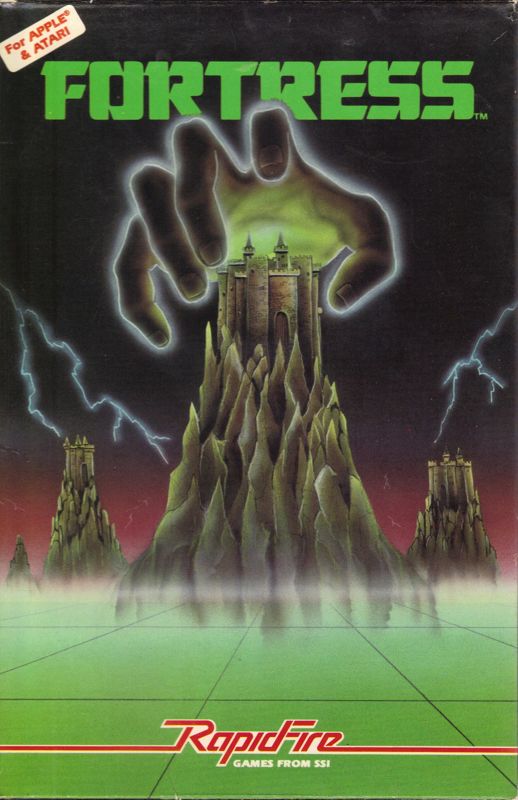
Fortress is the last SSI game for 1983, and while it is a computer board game and not a wargame, it deserves a full-fledged article for reasons that should be abundantly clear from the title of this article.
As Fortress is a board game, this won’t be a classical “narrated” After Action Report, but more of a game analysis. You may want to know the rules of Fortress before I start. They are fairly simple :
- A game lasts 21 turns. At the end of the 21st turn, the player who controls the most tiles on the board wins,
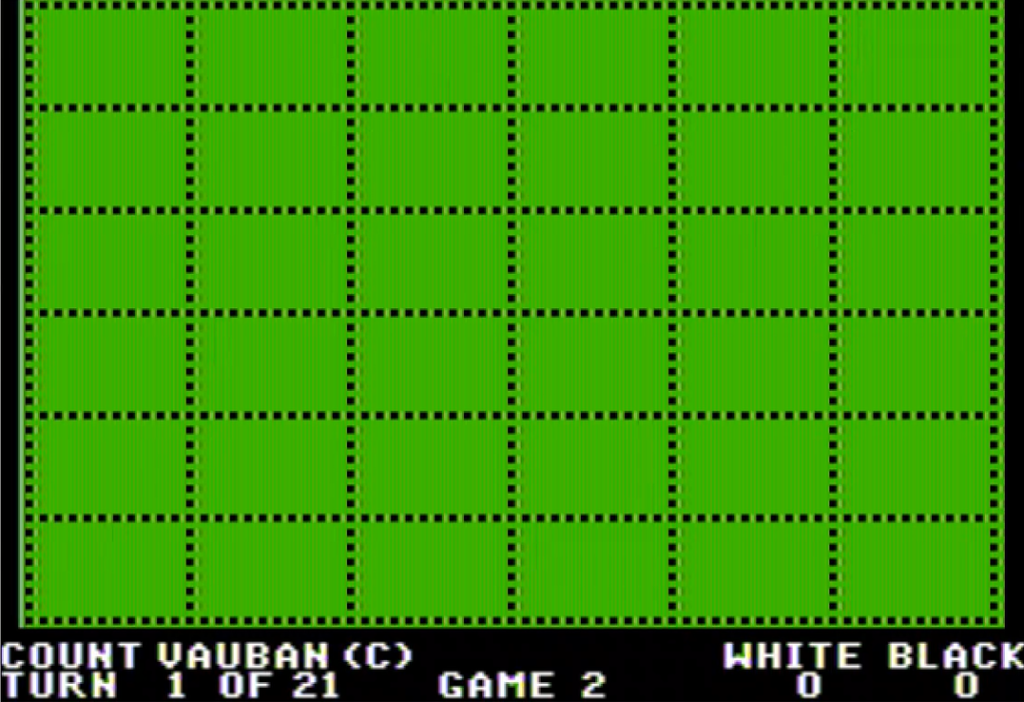
- Each turn, a player can either put a castle on the board or upgrade one of their existing castles once, up to “level 3”,
- A castle “projects” 1 in strength in its “zone of control” which is itself and the neighbouring tiles horizontally and vertically. Whoever projects the most strength on a tile controls it,
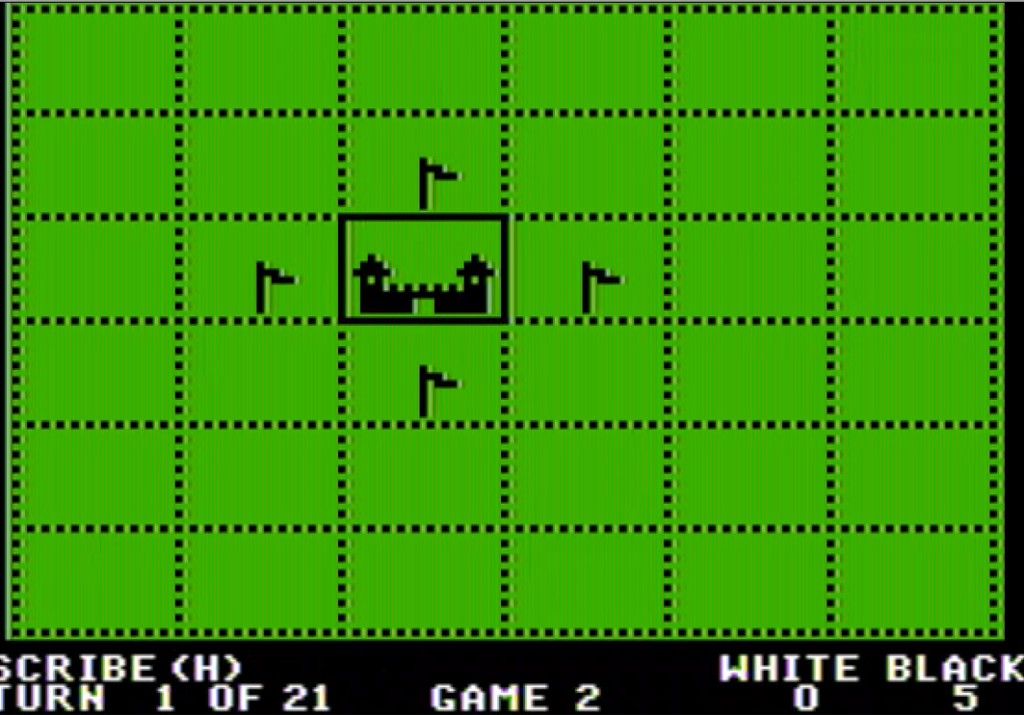
- Each upgrade of a castle adds +1 in the strength of the zone of control, up to a maximum of 3,
- Castles located on tiles controlled by the other player disappear,
That’s it. The game feels like a distant cousin of the game of Go, on a much smaller board.
I have already shown the first turn; this is the second round of a series of matches (a “tournament” according to the game) against an AI opponent called Count Vauban. I played first in the first match and won it, and now I play second. If I win this second match I will win the tournament.
Initially, Count Vauban and I put our castles in locations that allow us to take control of as many tiles as possible:
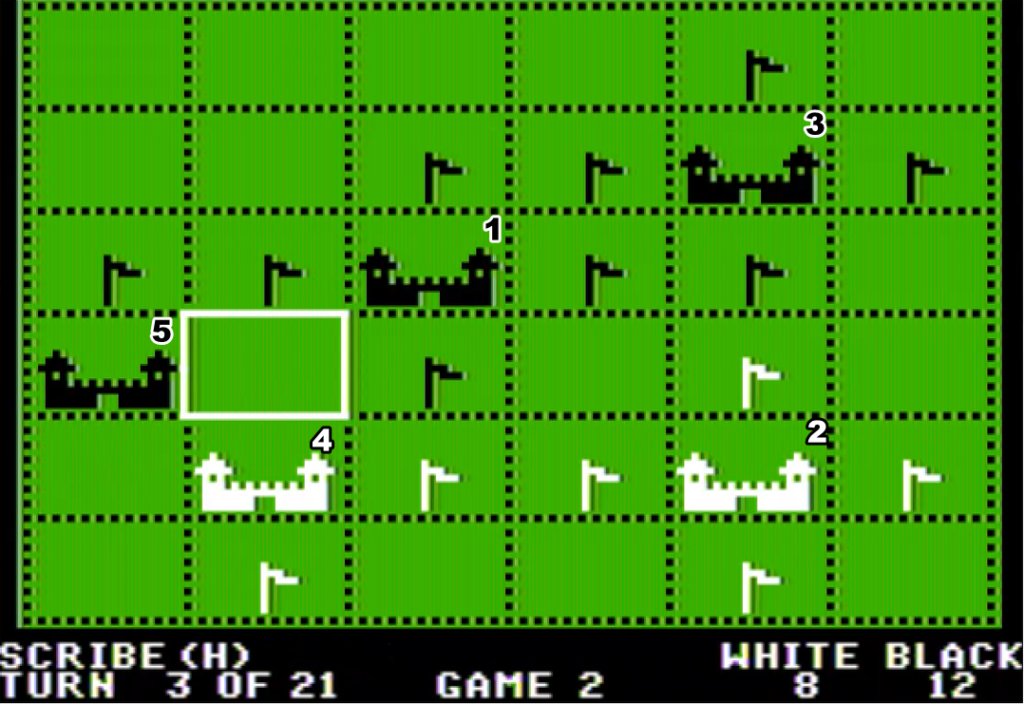
I still have one location where I could take control of 3 tiles and deny one to count Vauban (in the second tile from the top, second tile from the left) but that would give Count Vauban an opportunity to take initiative. Instead, I move aggressively in a location where I can threaten one of Count Vauban’s castles.
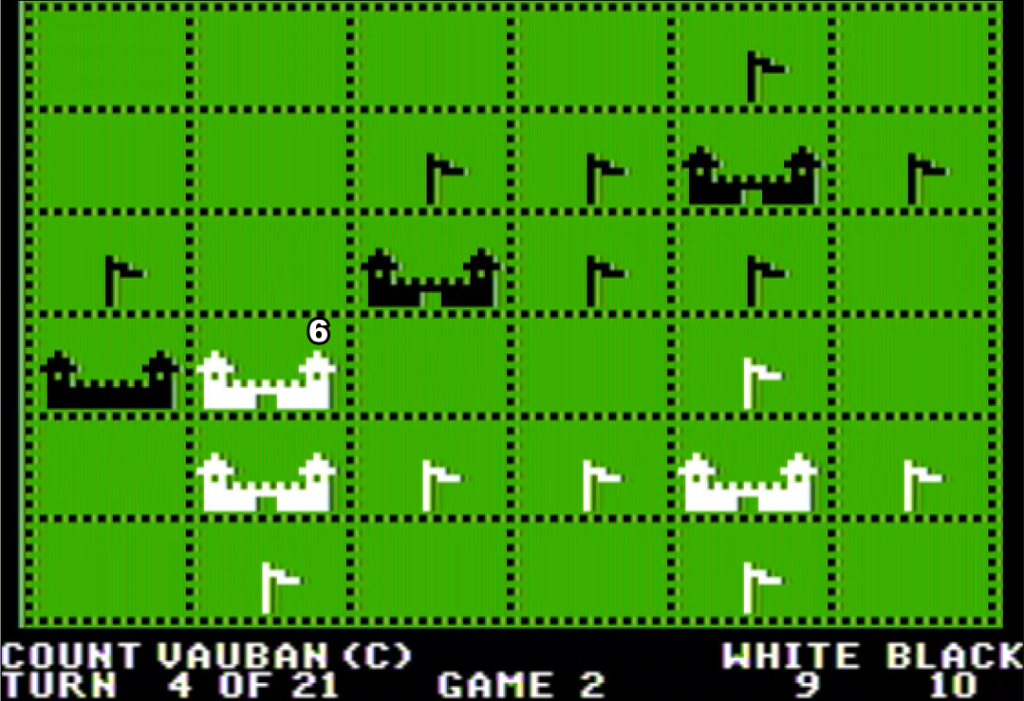
Vauban’s leftmost’s castle has closed its gate. It means it is at risk: if I put another castle next to it (or upgrade my new castle), then it will disappear. Vauban’s solution is to put a new castle next to the threatened one, reinforcing it defensively.
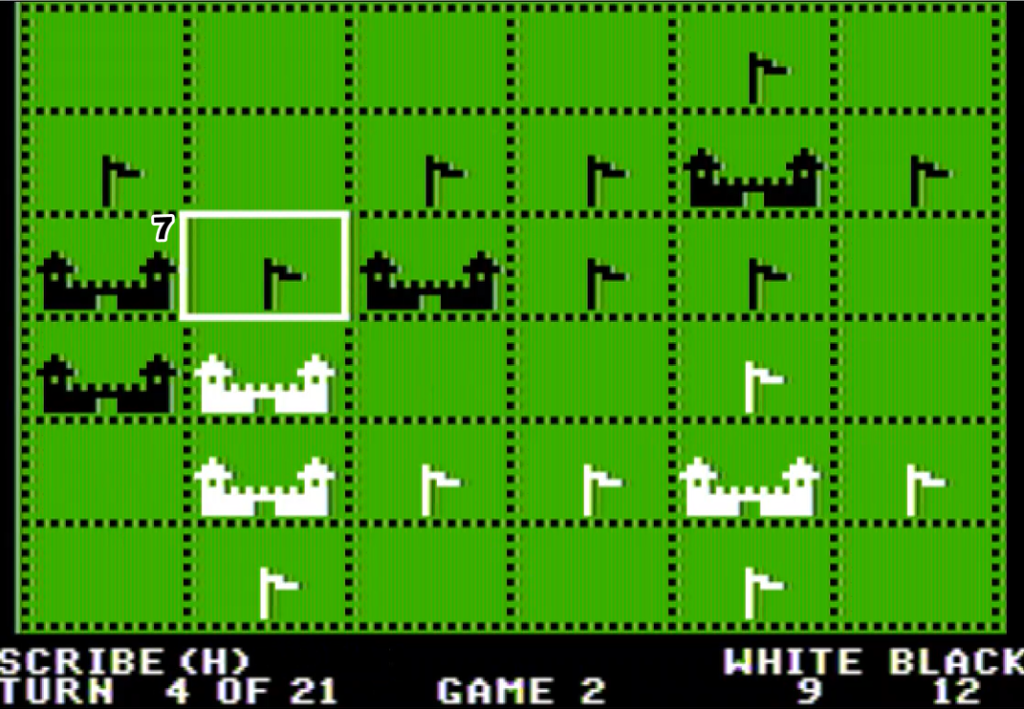
This opens a fork just right of Vauban’s last castle: a position where I could threaten two castles at the same time. Unfortunately, I can’t exploit it yet. If I put a castle there, it will be immediately “gate closed” and easy to remove. Instead, I prepare my fork my deploying a castle to the North, opening the future fork and challenging/taking control of 3 more squares.
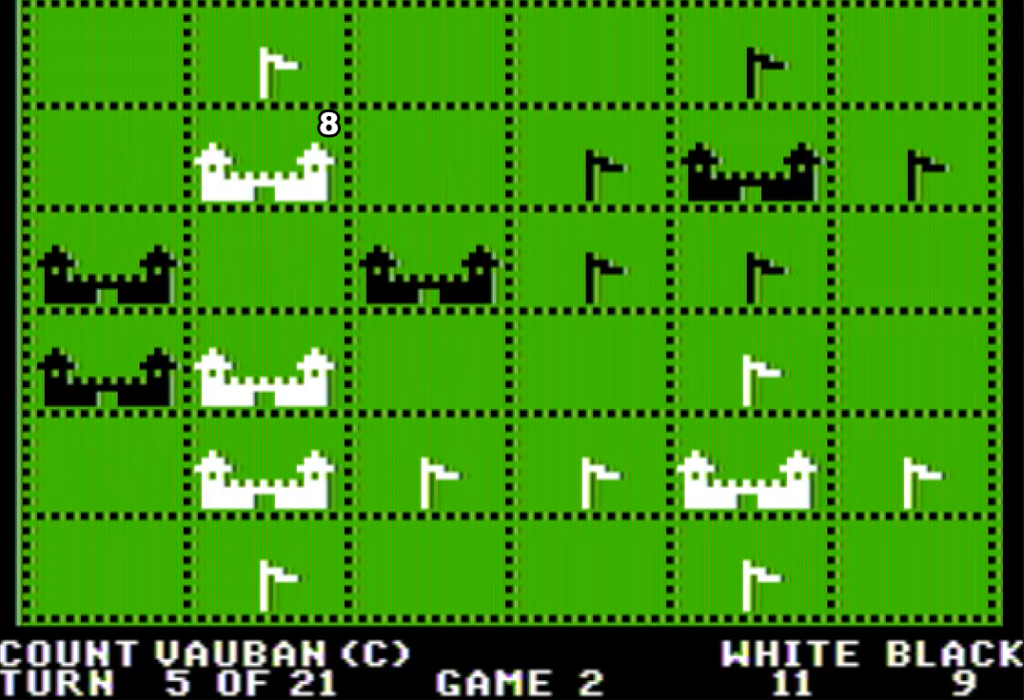
Count Vauban uses the opportunity to attack…
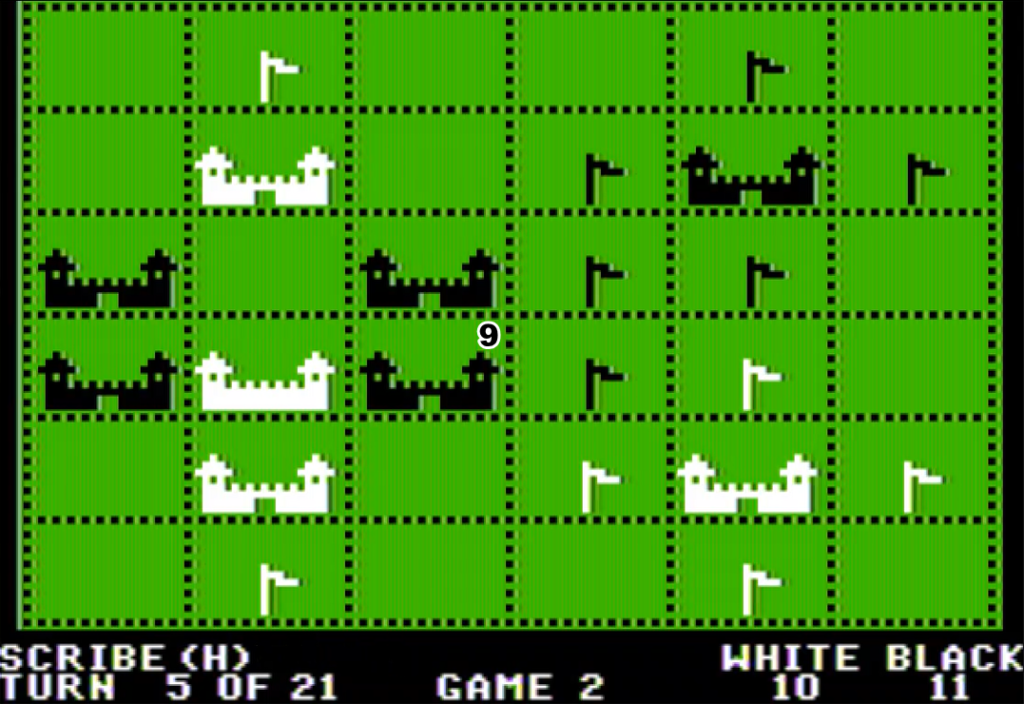
… but that’s not a great move. I add another layer to my castle, and now I have a fork where I did not plan one. Two enemy castles close their gates at the same time, and my opponent can only protect one.
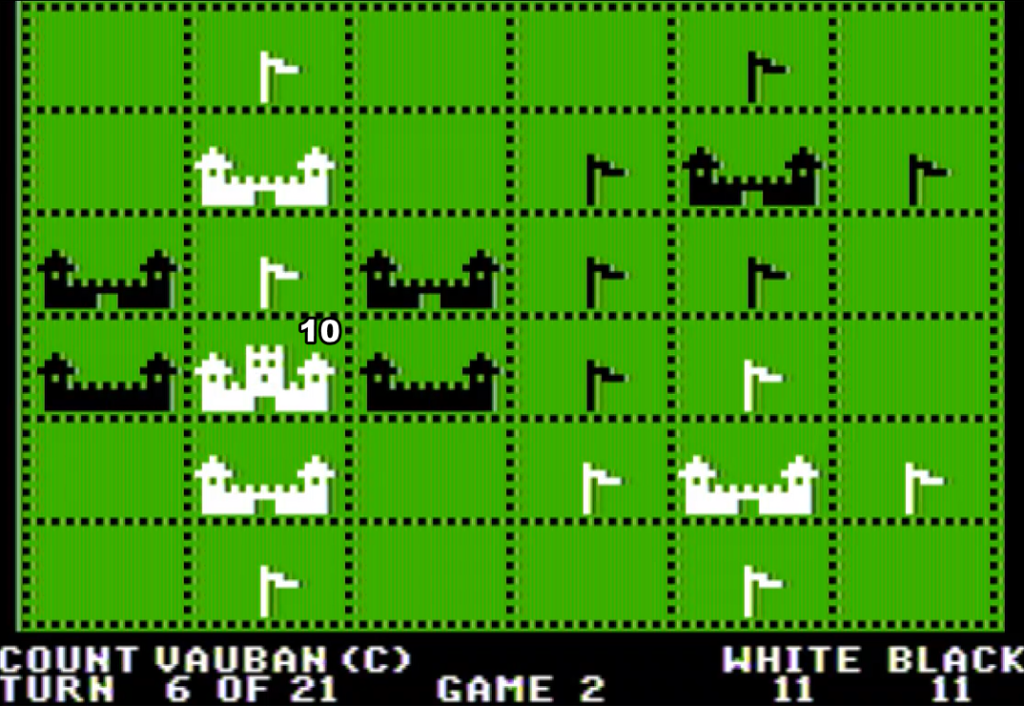
Vauban decided to protect the castle on the right, and I destroy the castle on the left by adding a third layer to my castle.
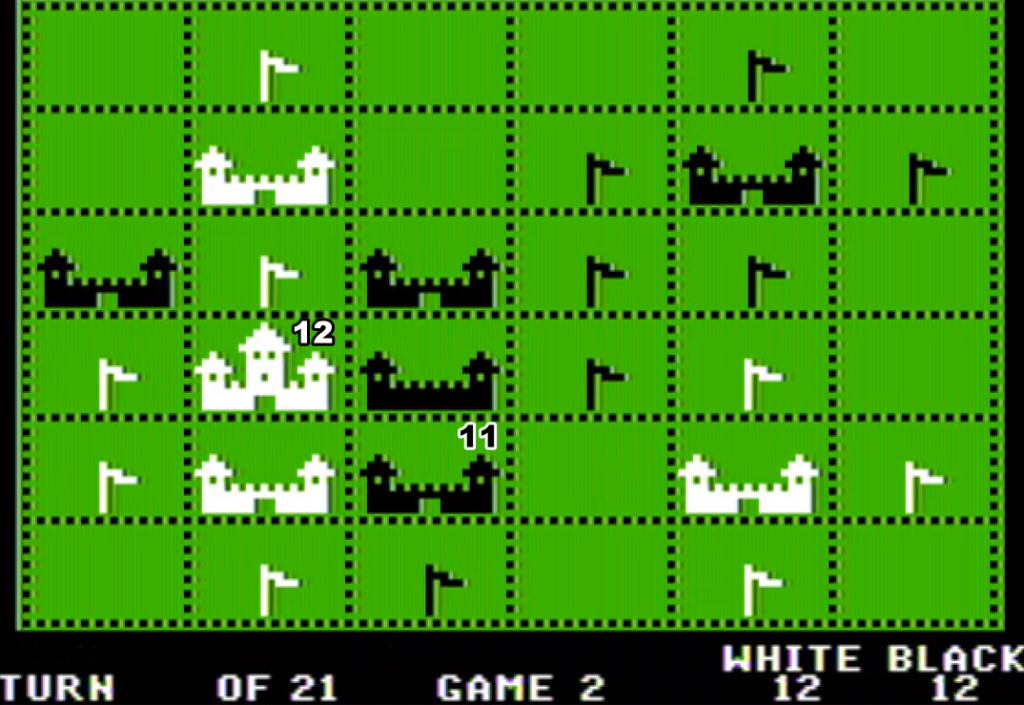
That’s not enough to give me an advantage: Vauban’s lost castle was not controlling much, and adding layers to an existing castle does not add to your territorial reach. I destroyed a castle, but I still have fewer castles in total – the score is still equal.
In any case, Vauban reinforces the center, and since I have the initiative I finally use the fork I had created earlier on.
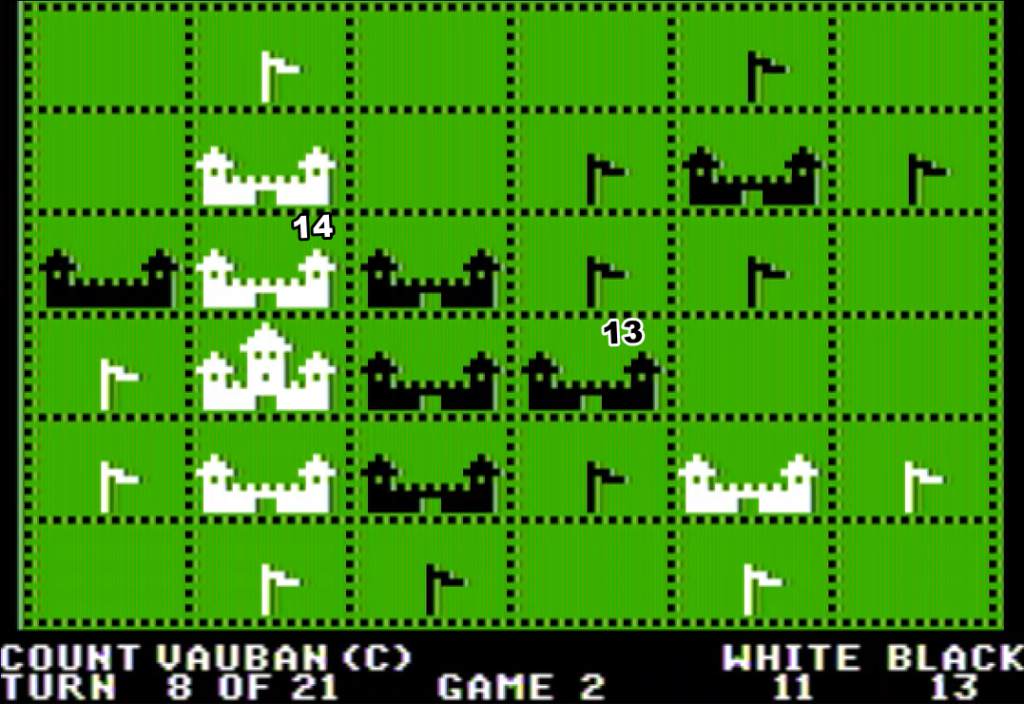
Logically, Vauban leaves me the two left columns and does not defend. What’s more surprising is that he positions his castle one row too high, which means that I keep the initiative:
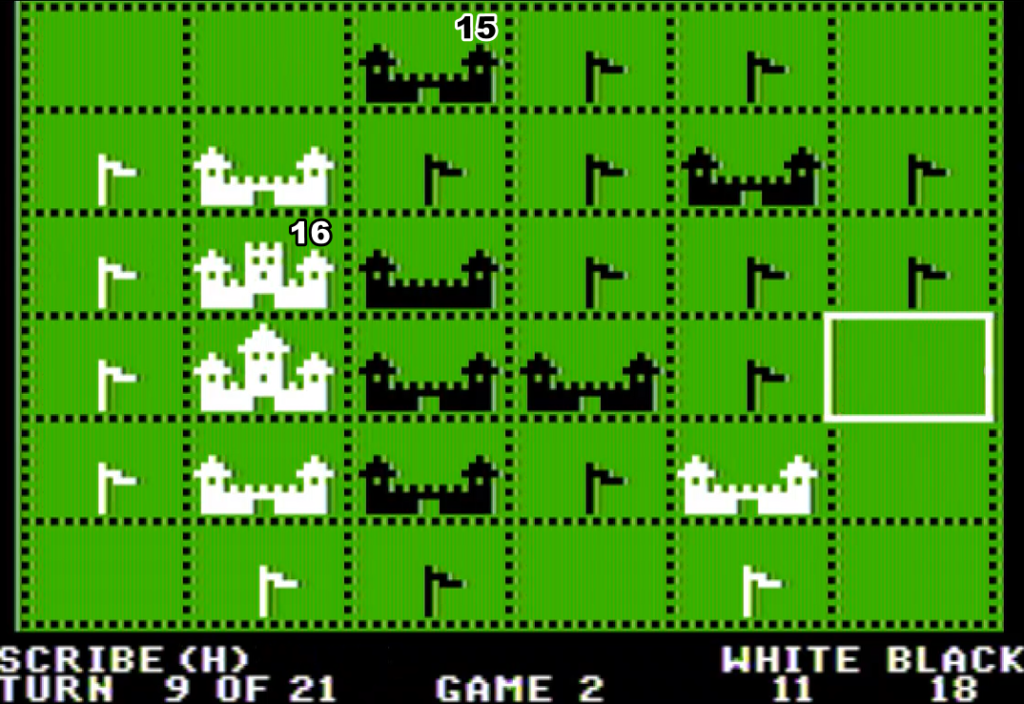
Count Vauban does not defend again, and I remove one more castle… I am still losing, so for all the lost castles Vauban must be doing something right, like trading castles for territorial control.
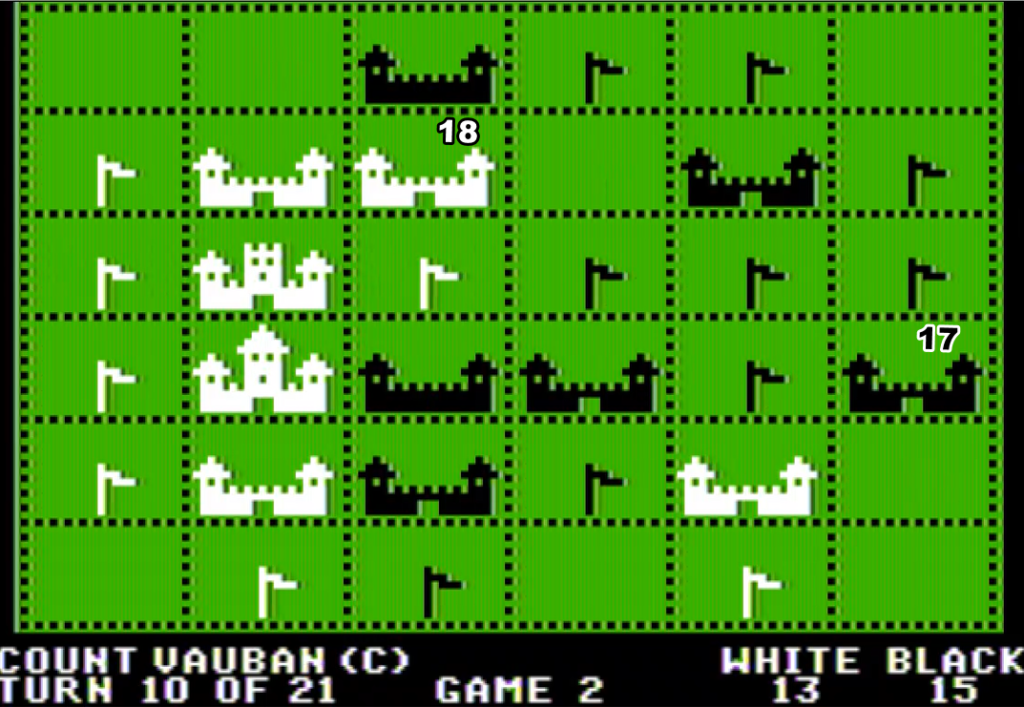
The following turns carry on the same way. I manage to take a minor advantage as I take one more castle in the middle.
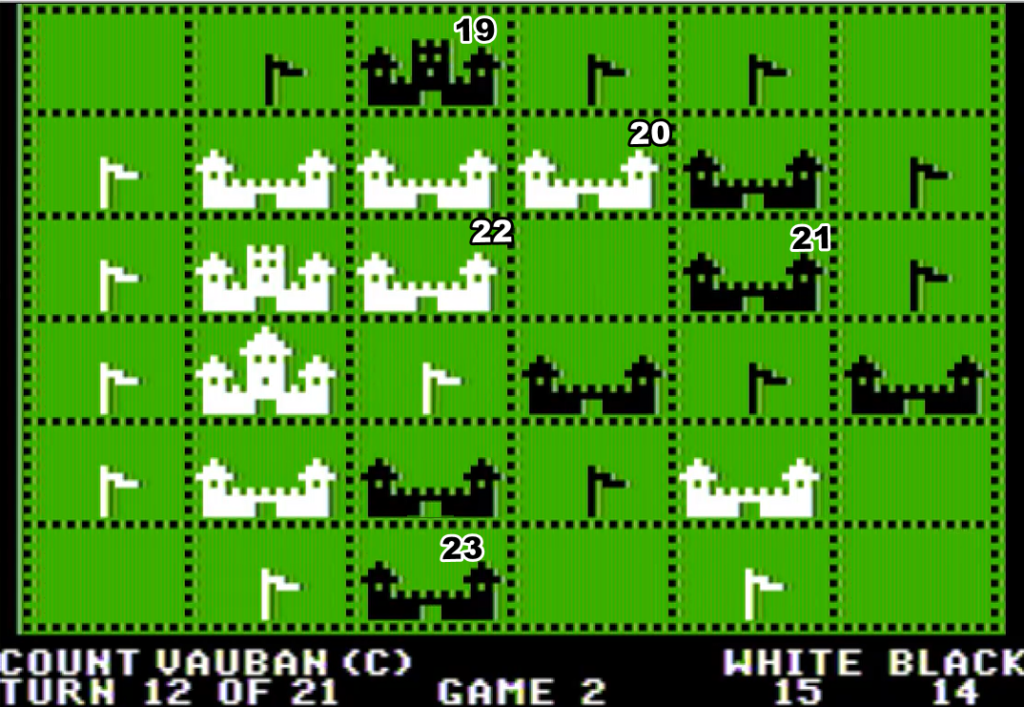
I try to attack to improve my position in the top-right quadrant, threatening two castles at the same time.
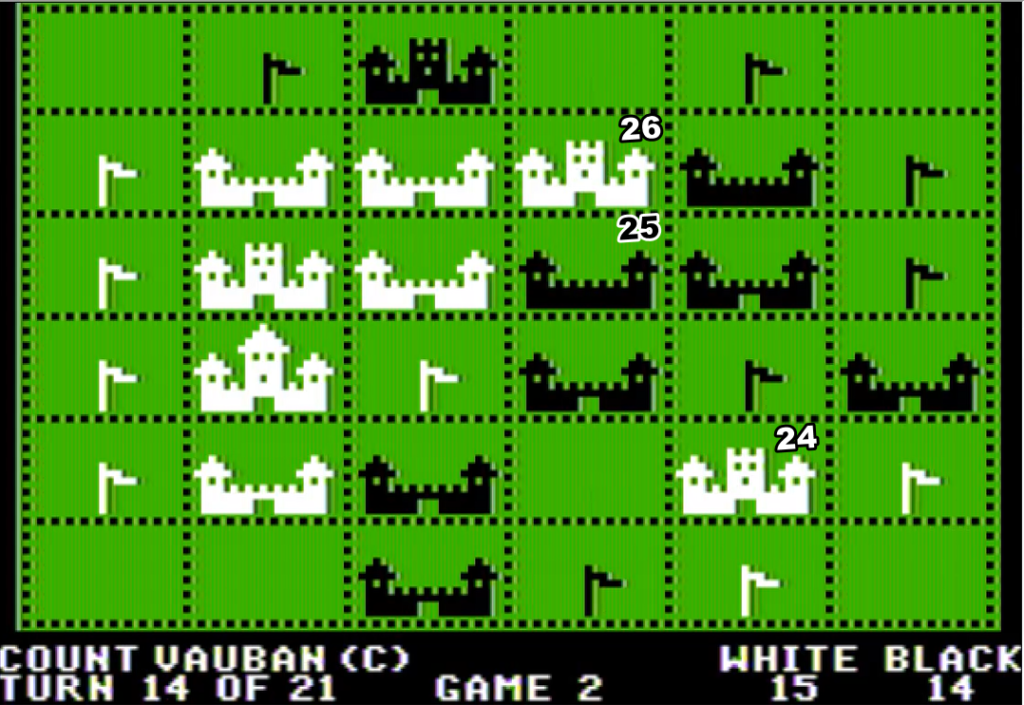
This is easy to counter for Vauban: he just needs to put a castle in the corner, defending both threatened castles at the same time. On the other hand, he can’t do the same in the bottom-right quadrant, because I control the location he needs to protect both castles…
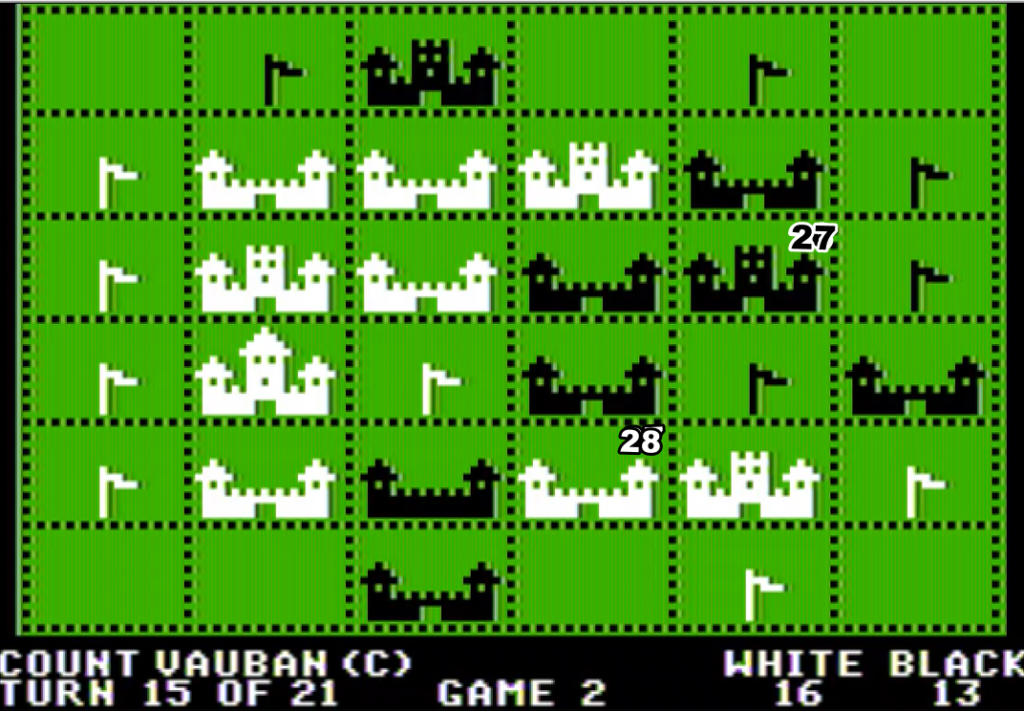
… and I take one castle, taking a decisive advantage.
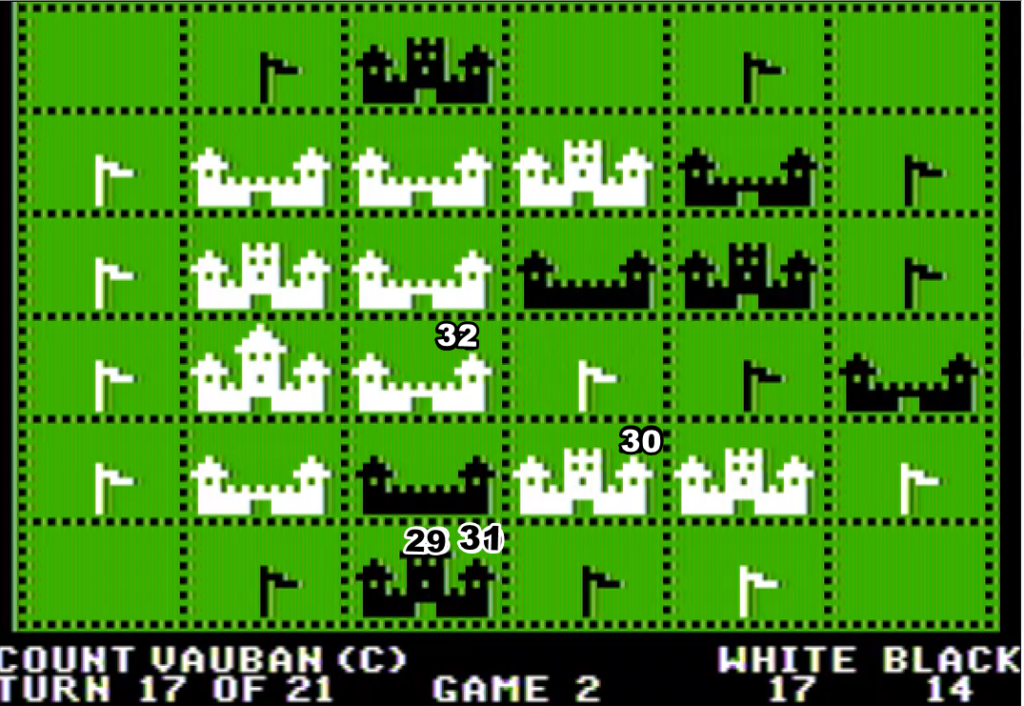
That’s almost impossible for Count Vauban to bounce back from, and the rest of the game is a series of moves that do not change the overall situation.
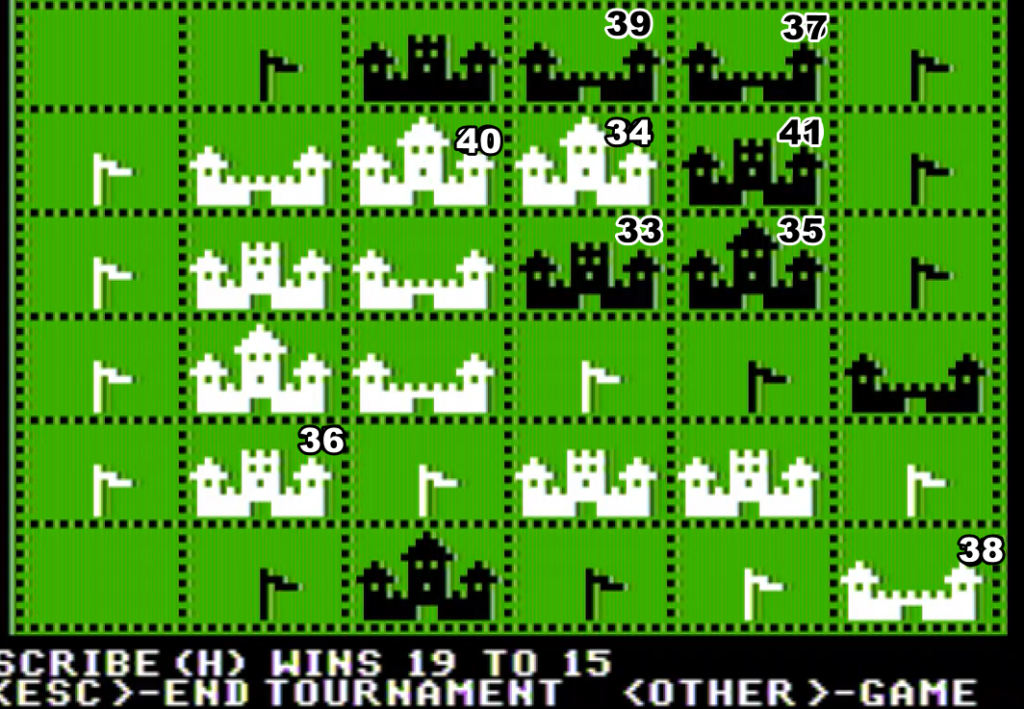
Though I have already won the “tournament”, there is a third round that I also win, leading to this final result:
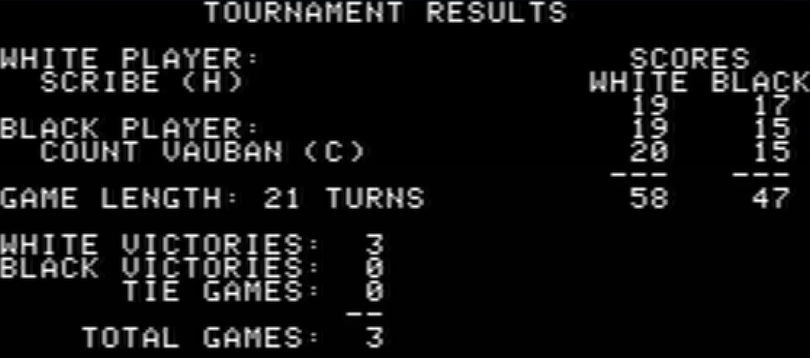
In the game I showcased, I think Count Vauban gave me the game in move #15. Earlier on, I had wasted time destroying some of his castles, but I controlled only 1/3 of the board plus an isolated castle in the bottom-right corner, so if he had defended properly he would have won or at least tied.
Ratings & Review
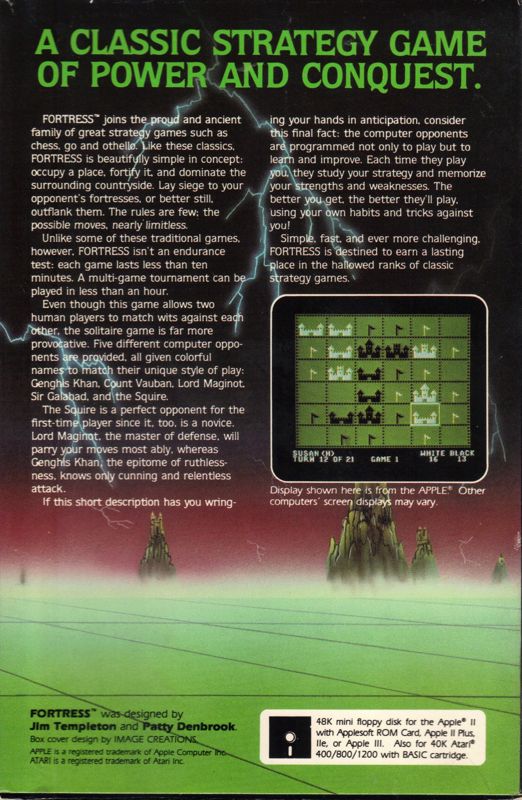
Fortress, by Jim Templeman and Patty Denbrook, published by SSI, USA
Genre: Boardgame
First release: September 1983 on Apple II and Atari
Average duration of a game : 10 minutes, more if you try to perform
Total time played: 5 hours
Complexity: Trivial (0/5)
Final Rating: Good
Ranking at the time of review: Not ranked (edit: 31/03/2024: 2-stars)
Sometime in 1983, SSI received a peculiar submission that should have been off-brand: a simple boardgame that could be played in a few minutes, without tanks, aircraft carriers or famous athletes. There was, however, something special to that submission that caught SSI founder Joel Billings’ attention: the virtual brain that was powering the opponent AI.
Fortress had been designed years before by James N. Templeman. In 1977, Templeman was an Electronic Engineering/Computer Science undergrad at the George Washington University (GWU), newly introduced to the field of machine learning. Keenly interested, he first worked on “a system that generated artistic geometric patterns based on how people graded each successive iteration“, and then worked on Babel – effectively an early version of Fortress running in BASIC on the HP3000 minicomputer, itself plugged either to a Cromemco Dazzler in all its glorious colours, or more commonly to a traditional black & white terminal. The ruleset of Fortress, inspired by the game of Go, had been designed to be trained easily by machine learning: the board was small and the matches were quick.
Babel was an interesting prototype where the machine learned to play, but Templeman eventually shelved Babel and during his master years he focused his efforts on computer graphics. After graduating in 1979, he worked first for NASA and then was recruited by fellow alum Patricia Denbrook at Honeywell. He did not remain there for long: in early 1982 Denbrook, himself and a third GWU alum left Honeywell to create Iconographics, described by ComputerWorld (29/03/1982) as “a new company offering services in computer graphics and image-based technology for micro- to medium-scale systems“. Consulting had periods of high activity as well as dry spells, and to fill the latter Templeman decided to turn the old Babel into a commercial product. The game did not need many additions: the “towers” of Babel (which were then simple concentric circles) were replaced by castles, small flags were added to show control for affordance, some sound effects were included and finally Templeman quickly pre-trained several computer opponents. It was then submitted to SSI.
Fortress was not the typical SSI game, but Billings had a niche for it: the RapidFire collection. The collection was at that point in time looking seriously inconsistent, mixing “rapid” games like Cytron Masters, Broadsides or Combat Leader with the monster 4X Cosmic Balance II and the endless RPG Galactic Adventures, the latter two because they were follow-ups to the shorter and simpler The Cosmic Balance and Galactic Gladiators. Still, while the long games had been commercial failures, the last batch of short games (Broadsides and Combat Leader) had been successful and it made sense to add more games. The problem was that Billings did not have any game fit for the collection in-house, so Fortress arrived exactly at the right moment.

They were the last games of the RapidFire series; in 1984 most SSI games ran at an appropriate speed as Assembly language and various technical tools sped things up, so the category became obsolete.
Fortress was released in September 1983 for Apple (port by Denbrook) and Atari (port by Templeman) at the price of $34.99, $5 below the usual $39.99 release price of SSI “small” games. The Commodore 64 port was added to the catalogue in March 1984. As a part of the marketing campaign, SSI launched a competition in Computer Gaming World in which users could submit their best-trained AI which would then fight one another (by platform), but unlike the earlier Cosmic Balance competition it went unnoticed – Billings remembers “10-20 entries at most“. Templeman remembers that the game was later (1988) licensed to Victor Musical in Japan, but alas I could not find any more information on this.
Most of my information comes from a conversation with James Templeman held in the comments section of a Youtube video of all places – there are a lot more bits of history to be read there.
And now, the ratings:
A. Scenario design & balancing: Outstanding. This is the section where I usually rate AIs, so for once I am putting it first because it is what makes Fortress so special.
As I explained, the AI trains as you play the game – after each tournament, the game asks you whether you want to include the session in your opponent’s training. As for a deeper explanation of how it really works, well, I will just refer to the manual for those interested in the technical details:
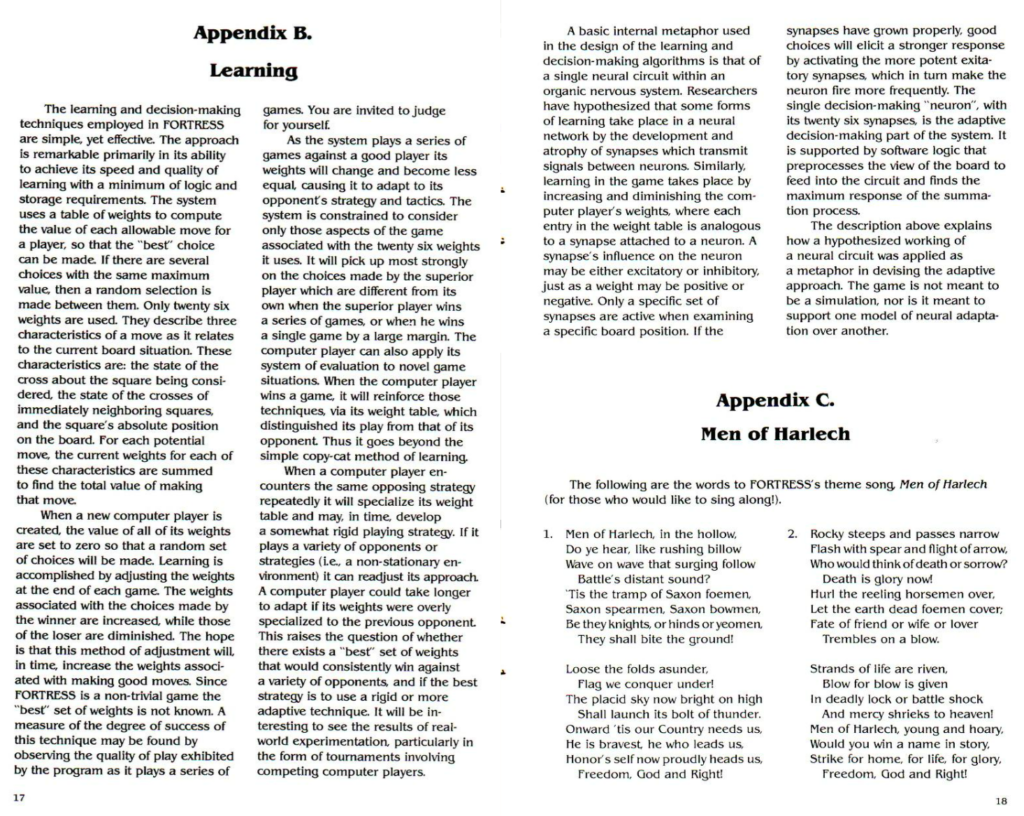
The game was shipped with 5 different opponents (3 advanced players : the aggressive Gengis Khan, the defensive Lord Maginot and the balanced Count Vauban), one intermediate player (Sir Galahad) and one newbie AI : the Squire.
While the Squire has never played any game, it can be used to train an AI from scratch – which is exactly what I did. Here are the results of 50 rounds against the Squire:
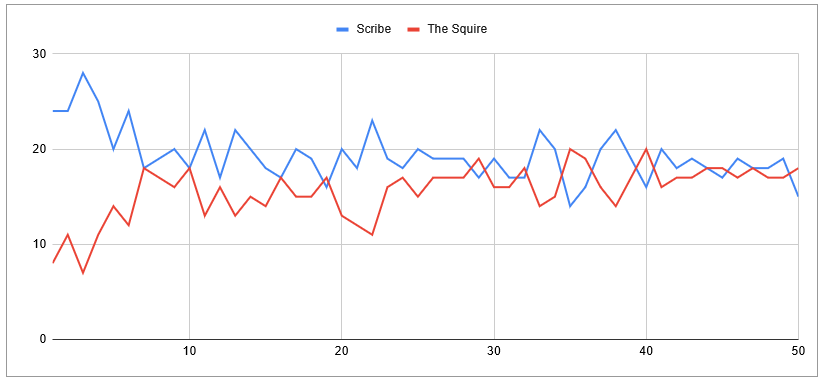
The chart is not a perfect measure of the speed of learning – I was not always 100% focused during the matches, some tournaments were multiple-rounds long and the Squire only updated its learnings at the end of the tournament, and I sometimes played against the other opponents so I may have had more opportunities to improve between two rounds. Still, the pattern is clear, as explained in the manual he made “random and often ridiculous moves during his first few games”, but quickly learned. By round 30, I had to pay attention. By round 40, I stopped “high risk, high reward” moves because he was often punishing them.
B. Systems: Good. Even without taking into account the AI, it is a solid ruleset: trivial to learn but deep. One can debate endlessly about the best opening or about when to pivot from attack to defence. It has everything I like in Draughts: initiative/tempo, forced moves, and gambits. You can see several moves in advance and plot “multi-capture”. Just like in Go, it also has this subtlety that taking enemy castles does not guarantee victory at all: while you were attacking, your opponent may have reinforced somewhere else.
I am not sure that, if Fortress had existed as a board game when I was younger, I would have played it as much as I did Draughts and Chess before being bored of it. After 60+ games I start to see the same patterns again and again. Still, I definitely plan to create a small physical board and try to find opponents in the real world. I am just a bit afraid that not being able to quickly visualize ownership of squares without the flags may limit my enjoyment of it somehow.
C. Immersion: Adequate – which is the best one could expect from this type of board game. The game has sound effects, the AI opponents have vivid descriptions and the manual even includes the lyrics of the game’s theme song (“Men of Harleck“).
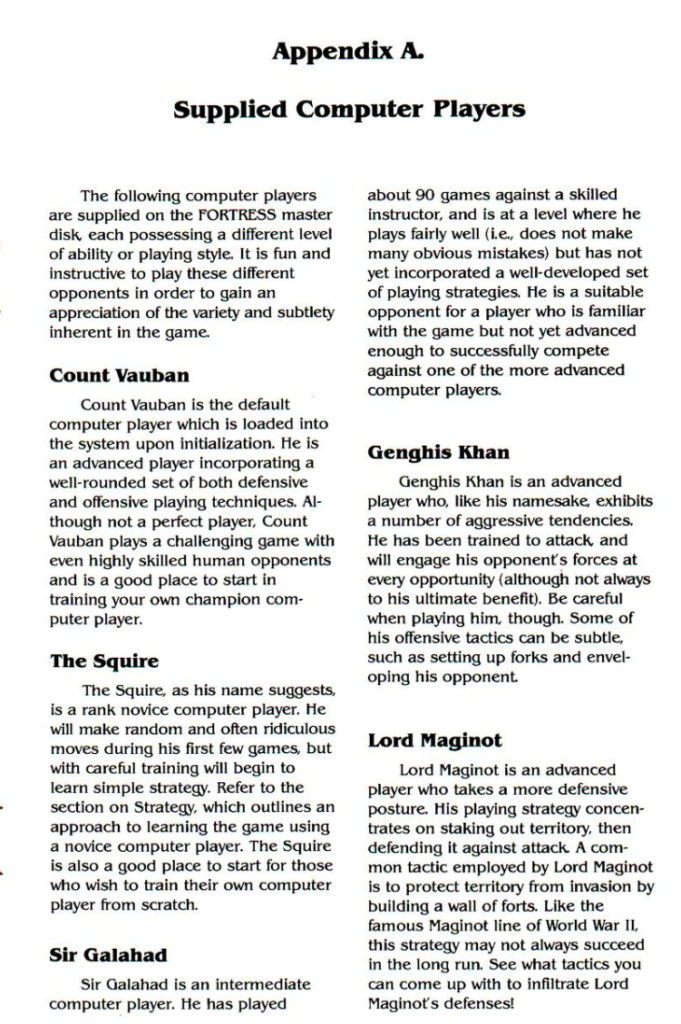
D. UI, Clarify of rules and outcomes: Good. I have played my share of computer Chess and International draughts in the 90s. None had a better UI than this 1983 game to check for instance the history of your matches.
E. Did I make interesting decisions? Every turn.
F. Final rating : Good. By its very nature, this type of board game does not age. If it was good then – and it was – it is good now. But as a caveat please note that I am not the typical audience; as I explained in an earlier article I used to play abstract board games competitively so of course a game like Fortress will pique my interest.
It is very hard for me to rate Fortress in my “order of preference” list. I don’t like playing abstract board games on a computer, and I don’t like playing abstract board games against a computer. Additionally, it is not a wargame, and my list is for wargames (or wargame-adjacent enough) – it would make no more sense to compare Fortress to Germany 1985 than it would to – say – sort a list including both Chess and Rugby. It is already hard enough to compare Reach for the Stars and Eastern Front 1941. Still, try it out! Edit: I still did it on 31/03/2024 after rating Computer Diplomacy and it ends 28th out of 128 games. I li
Reception
Fortress received warm reviews, most of them mentioning the adaptative AI. In Computer Gaming World, Fortress was covered by no other than Scorpia in December 1983, who concluded directly: “If you like strategy games, this is one you’ll want to have“. This is the tone of most reviews I read:
- William H. Harrington writing for Softalk, January 1984: “Combining the elegance of a simple, easily learnable game with real strategic sophistication and an opponent who learns. Fortress provides fast-paced play, considerable challenge, and not a few surprises for board game enthusiasts.”
- Edward Bever writing for Antic, April 1984 : “Simple, fast and well-balanced. Fortress should appeal to anyone who enjoys a game that makes you think“
- The 1984 Software Encyclopedia gave it a 8/10, and an “Excellent” rating in Solitaire,
Fortress also impressed in France. In October 1984, the French generalist magazine Jeux & Stratégie listed it among the “33 best video games of all time.” Returning to the game two years later in 1986, they still gave it 5/5.
The SSI staff was another audience on which Fortress made a huge impression. At the time, Charles Merrow (author of Computer Baseball and Figher Command) singled out Fortress in an article called “The Computer as Opponent” (CGW, October 1984), it was according to him an exception to the rule that computer opponents are not able to “learn or adapt”. Dozens of years later, Joel Billings advised me out of the blue to check the game when we were still discussing 1982 games, and Paul Murray asked me at the end of a discussion on Road to Gettysburgh whether I could help him find a copy of it, adding that “[he] had been impressed at the time“.
Unfortunately for SSI, sales were mediocre : 4970 copies, the second worst performance of 1983 after Queen of Hearts and its 1180 copies sold. The AI winter that followed from the second half of the 80s to the early 2000s ended everyone’s enthusiasm for real artificial intelligence as computer opponents. As we are now in an AI Boom, I expect future wargames to embark on neural network opponents. When this happens, I will be able to look appropriately jaded and say “this is not bad, but this is not new either. It was first done in 1983! In BASIC!“
Patricia Denbrook and James Templeman never worked on a commercial video game again. Templeman went back to University to earn a Doctorate in Computer Science, and then worked for the US Navy’s Naval Research Lab with Denbrook. As for Fortress, it made the news one last time in 2019 in the least expected way possible when it was found out that a popular (?) Australian band (“King Gizzard and the Lizard Wizard“) ripped off the box art of Fortress for the cover art of one of their albums. Louis Saekow – SSI’s packaging artist – managed to get credited and received some merchandise in compensation.

Fortress is the last game for 1983, so the next update will be a bit of an overview of the state of the computer wargame niche at this point, something I should have done when I ended 1982 and 1981 already!
5 Comments
Previous to this I was unaware of Fortress. Very cool to read about the origins and bonus content in the YouTube comments. Nice work!
An interesting read about a cute little game. Re. the inclusion of the lyrics to “Men of Harlech” in the manual, I wonder whether the authors were fans of the 1964 film ‘Zulu’ in which it featured prominently… or perhaps they were just patriotic Welsh.
I also couldn’t help but chuckle, thinking what the CRPG Addict would have to say about the inclusion of Sir Galahad in the catalog of opponents!
I would love to read an article on Chris Crawford’s Excalibur by the cRPGAddict myself, but there is no way to reframe it as a RPG.
Yes, I enjoyed the Welsh refrain playing off against the Zulu war song (even without the top Welsh tenors).
However, “Men of Harlech” was chosen as a reference to the siege of Harlech Castle.
P.S. My mom was a war bride from Southport England.
What a fantastic read and an interesting way of doing things! Queen of Hearts intrigued me until I saw it was pinball.
But the AI learning how to play is a really neat idea. And the “minutes to learn, lifetime to master” is very cool.